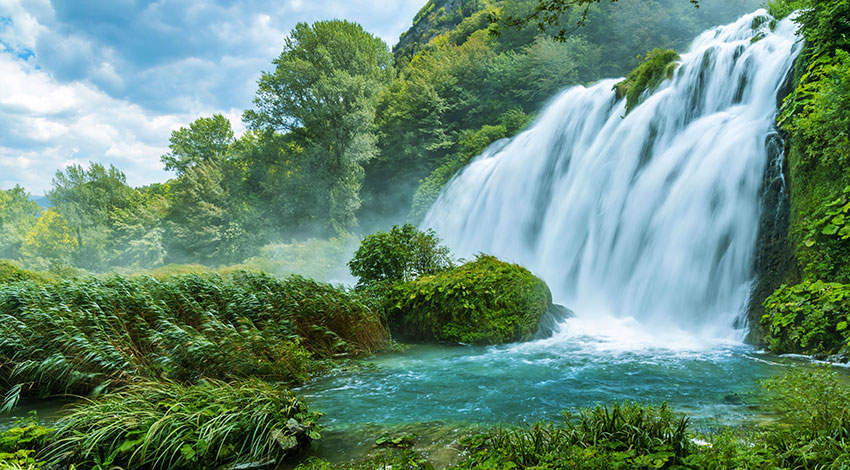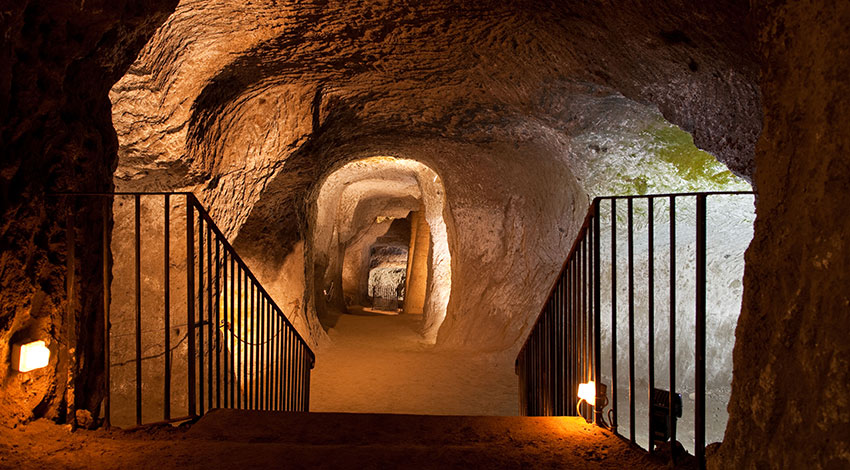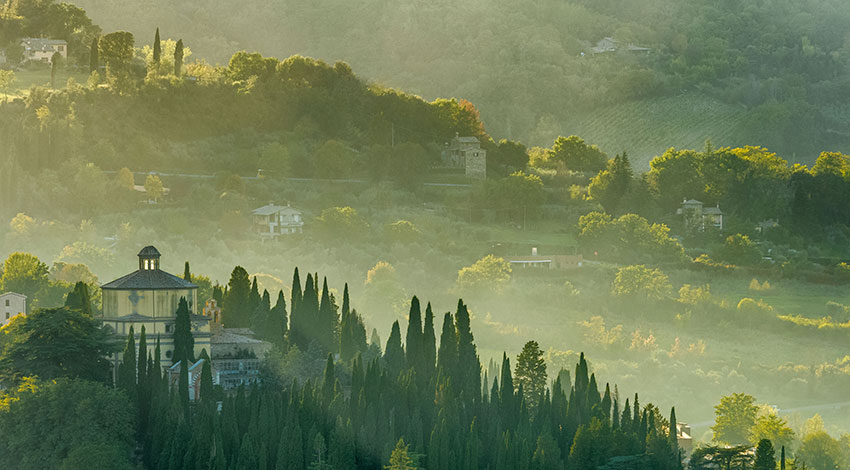Discover the Underground Orvieto Etruscan Caves of Italy
Central Italy is known for its slow pace, breathtaking views, and remarkable architecture. Tuscany and Umbria are two regions located in the middle of Italy, and are home to world-renowned attractions like Michelangelo's David statue, the Duomo basilica, and the olive groves and vineyards of Chianti. While these destinations and attractions are well worth the visit, long lines and crowded spaces can be overwhelming. For those looking to immerse themselves in Italian culture, it’s time to explore off-the-beaten-path destinations in Italy.
In this guide, we’ll highlight the hidden gems in Tuscany, Italy, secrets in Umbria, what to do in Orvieto, and more. As you prepare for your next adventure, use this list to find unfrequented landmarks in the hidden villages of Tuscany and Umbria to get a true Italian experience.

Secret Umbria and Tuscany
Umbria and Tuscany are two regions in central Italy known for their rich history dating back thousands of years. If you want to explore these regions without the crowds, consider these sites, landmarks, destinations, and attractions:
- Marmore Falls: This secret of Umbria is well worth the hike. Marmore Falls is Italy’s second-tallest waterfall and it’s man-made. Created by the ancient Romans, Marmore Falls can be turned on and off. A visit to Marmore Falls is perfect for outdoor adventurers, as you can find hiking trails, caving, rafting, and canyoning tours.
- Montone: Another hidden gem is the Umbrian village of Montone. Dubbed as “Museum Valley” for its breathtaking scenery and landscape, Montone is a perfectly preserved medieval town where visitors can marvel at centuries-old architecture, statues, and more.
- Appennine Colossus at Villa Demidoff: Florence is known for renowned works of art, such as the Uffizi Gallery, Giotto’s Bell Tower, and Ponte Vecchio. However, a mere 30-minutes from the city center is a lush garden and beautiful villa that’s home to the Colosso dell’Appennino, a 16th-century statue created by Giambologna.
- Lake Trasimeno: If you’re an avid birdwatcher, Lake Trasimeno is a must. As Umbria’s largest lake, bird lovers can find cormorants, wild ducks, and other feathered friends gliding along the lake. This secret spot is also great for swimming, recreation, and relaxing while taking in the views.
- Saturnia Hot Springs: This hidden gem in Tuscany, Italy, is the perfect place to visit after a long day of exploring. The Saturnia Hot Springs is a little over two hours from both Rome and Florence, and boasts free natural thermal hot springs and waterfalls open year-round.
These are just some of the secrets of Umbria and Tuscany worth visiting on your trip to Italy. Explore more hidden gems, such as the Orvieto Etruscan Caves, below.

What to Do in Orvieto, Italy
Orvieto, Italy, is an Umbrian village located in the Province of Terni in southwestern Umbria on a butte of a volcanic tuff. The history of Orvieto dates thousands of years, starting in the 9th-century BC when the Etruscan civilization inhabited the area. Originally called Velzna, Orvieto is located in a strategic area, allowing the Etruscans to build a military town strong enough to hold off the Roman empire for years. However, the Romans prevailed, and in 264 BC, gained power.
During the Middle Ages, Orvieto became a prosperous and flourishing city, becoming modernized and expanding. Today, Orvieto is an ancient town full of charm and stories worth exploring. With so much history, here’s a list of what to do in Orvieto, Italy:
- Visit the Orvieto cathedral, also known as the Duomo, and marvel at Gothic and Romanesque architecture, detailed mosaics, and statues.
- Check the time at Torre del Moro, a clock tower standing 47 meters high. You can even climb to the top for a stunning view of the city.
- Relax at Rocca-Fortezza Albornoz, a public park housed in an ancient fortress that offers beautiful Umbrian scenery.
- Explore Belvedere, an ancient Etruscan temple, and Pozzo di San Patrizio (St. Patrick’s Well), which has a set of twin staircases with 248 steps each going down into the well shaft.
If you’re wondering what to do in Orvieto, Italy, we’re not done yet. Below, we’ll uncover one of Orvieto’s hidden gems, the Orvieto Etruscan Caves.
Where is Orvieto, Italy?
Orvieto is located in the region of Umbria in Central Italy. It sits atop a volcanic bluff and is approximately 75 miles north of Rome and 99 miles south of Florence. Orvieto is extremely accessible, with plenty of trains coming from various major Italian cities. If you’re looking to explore underground Italian caves, Orvieto is a great destination. An underground tour of Orvieto will ensure a wealth of newfound knowledge and lasting memories.

Orvieto Etruscan Caves
Believe it or not, under the town of Orvieto is an elaborate maze of tunnels and caverns. Over 2,500 years ago, the Etruscan civilization dug deep into the earth to supply their town with water. During the process, they began building a series of wells and tunnels that continued well after the Romans and into the Middle Ages. Today, there are over 1,200 tunnels in the Orvieto underground caves, along with galleries, grottoes, quarries, shelters, and cellars. The construction of the Orvieto underground caves tunnels had no formal plans, creating a labyrinth of passages deep beneath the city.
For history lovers, a trip to the Orvieto underground caves is a must. As you wander the caverns and tunnels, you’ll get a glimpse into life several millennia ago, allowing you to witness architectural wonders and subterranean construction projects that stood the test of time.
Attractions of the Underground Orvieto Etruscan Caves of Italy
The Etruscan Caves of Orvieto are a fascinating historical and cultural attraction, having been used for centuries to access natural resources, particularly water. Throughout the Middle Ages, the labyrinth beneath the city of Orvieto continued to grow as generations continued to build an array of tunnel systems complete with millstones, storage structures, troughs and even an olive press station.
Before diving into some of the top attractions of the underground Italian caves in Orvieto, it’s important to understand the ancient Etruscan culture. The Etruscans were a civilization that thrived in Central Italy from around the ninth century B.C. to the first century B.C. They were skilled architects, engineers and urban planners, known for creating well-organized settlements with advanced infrastructure, including roads, irrigation systems, wells and sewers.
However, over the centuries, the Etruscan civilization slowly declined. The downfall started in the fifth century B.C. due to conflicts with neighboring civilizations, internal strife and, most notably, the expansion of Rome. By the first century B.C., the Etruscans were completely assimilated into the Roman Empire, with their culture and language gradually disappearing.
Now that you know who the Etruscans were and their many accomplishments, let’s explore some notable attractions they created in one of their cultural hubs, Orvieto, called Urbs Vetus and Velzna by the Etruscans. If their intricate architecture and infrastructure intrigue you, take a look at some of the top attractions in the caves of Italy built by the Etruscans in Orvieto:
-
The Quarry Well: Around 1527, Pope Clement VII ordered the construction of the Quarry Well, which is over 30 meters deep. This well was built on top of an existing well built 2,500 years prior by the Etruscans and was only used until the middle of the 17th century. As you make your way to the well, you will also come across hollows, which are rooms that were used as furnaces for ceramics.
-
The Well of Saint Patrick: Another famous well found in the caves is the Well of Saint Patrick, also ordered by Pope Clement VII around 1527. This well was constructed by Antonio da Sangallo the Younger and was intended as a water source should the city ever fall under attack. What makes this well an iconic attraction in the Orvieto underground caves is the double-helicoidal staircase that made it easy for animals to come and go unobstructed.
-
Underground streets: The Etruscans built an intricate network of streets below the city of Orvieto that made easy transportation possible. By excavating tuff (a type of volcanic rock), the Etruscans were able to build an entire city that was well fortified and organized. Through an underground tour of Orvieto, you can discover remnants of ancient houses, wells, workshops and escape routes used during times of conflict.
-
Architectural features: Throughout the caves beneath the city of Orvieto, you can marvel at the countless artistic and architectural features, including frescoes and carvings that adorn the walls. The artwork depicts scenes from everyday life, religious symbolism and mythological figures that defined Orvieto's culture and way of life.
-
Mill of Saint Clare: One of the most prominent attractions in Orvieto's underground is the Mill of Saint Clare, an ancient olive press that supplied the town with fresh oil. When touring the Mill of Saint Clare, you will find the large basalt millstones used for crushing olives as well as information about the history of the olive press from the Middle Ages to the 17th century.
-
Underground tours: You can partake in an underground tour of Orvieto that brings you through the caves. These tours are led by local experts and will provide keen insights into the history, architecture, art and culture that made these caves so important to the Etruscan civilization.
These are some of the top attractions you can find in these underground Italian caves. However, there’s much more to Orvieto — visitors can also enjoy a wide range of attractions and activities throughout the city.
The Etruscan Necropolis is a popular attraction. This cemetery, located on the outskirts of Orvieto, provides insights into Etruscan burial customs and rituals, allowing visitors to view carved tombs and decorative elements.
Another popular attraction is the Orvieto Duomo, where visitors can view the Chapel of San Brizio. The chapel contains one of the world’s most significant pieces of Italian Renaissance painting, with the fresco decorated by Benzolo Bozzoli, Luca Signorelli, and Beato Angelico. This chapel has a large layout that gave these artists free rein to paint a variety of important frescoes depicting various religious events, such as Christ sitting in judgment surrounded by angels, the apostles and the Virgin Mary.
As you can tell, Orvieto has a lot to offer its visitors. At Road Scholar, our experiential learning tours can bring you throughout the Umbria region to explore areas like the caves of Orvieto. Through our tours, you can enjoy spirited conversations with other group members while learning about the ancient Etruscan civilization responsible for the magnificent architectural and artistic features found in the city of Orvieto and beyond.

Hidden Gems in Tuscany, Italy
Tuscany is a region filled with history, culture, and cuisine. If you’re looking to explore off-the-beaten-path destinations in Tuscany, consider some of these items on this list:
- Le Dieci Castella, which translates to “The Ten Castles,” is located in the city of Pescia, which is surrounded by ten hilltop villages that were once home to medieval castles. Escape the buzz of the cities and enjoy peace and calmness down cobblestone streets, and maybe even sign up for a cooking in Tuscany program.
- Put yourself in the shoes of famous Renaissance artists by visiting San Miniato, another hilltop town with beautiful scenery overlooking the Arno River Valley.
- For beach dwellers, you can’t go wrong with a stop at Porto Santo Stefano, a beach town located on the southern coast of Tuscany. Here, you can enjoy crystal blue waters, exciting boat rides, and seafood.
While this list is nonexhaustive, these are just some of the hidden gems in Tuscany, Italy, worth visiting.

Visit Tuscany and Umbria with Road Scholar
At Road Scholar, we have a wide range of educational travel adventures to Tuscany and Umbria. From walking the hilltowns of Umbria to online Italian adventures, our expert-led learning programs will immerse you in Italian culture.
Enroll now to walk down the Italian path less traveled!
